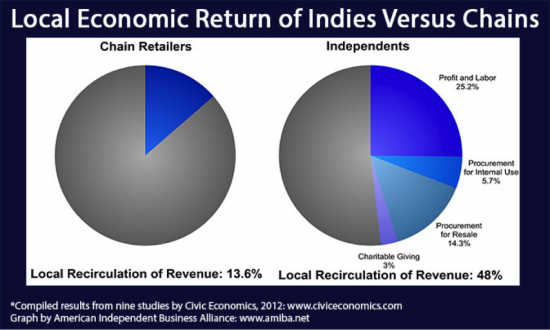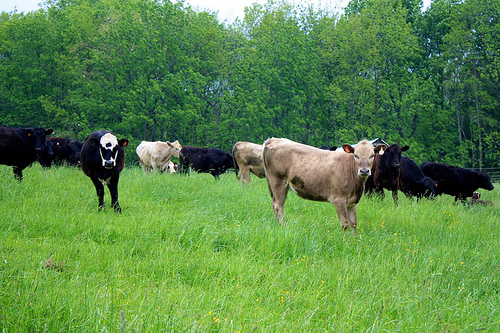Hey folks! I’m really excited to try to charge you all up about this idea I’ve got at the end of this post. As part of the Ancestral Health Symposium for 2013, nutritionist, farmer, and author Diana Rodgers and I did a presentation called, “Liberation from the Industrial Food System”. We’ve got a short recap of the talk here and will post the video link as soon as it’s available. Scroll down to catch the highlights of what we covered, then at the end, you’ll see ideas on what YOU can do to make a difference!
You can grab the slides from the presentation here. Check out Diana’s website at www.radiancenutrition.com.
Why buy small scale?
Buying from small scale food producers is a great way to not only get fantastic food, but also support local economies, animal welfare, biodiversity, and support fair treatment of farm workers. Plus, there are organizations that are helping to educate people across the world to grow their own nutrient dense food, we can actually make a dent in the global warming problem as well.
Local Economies
The importance of buying local rather than at a chain store is illustrated by this chart:

For more information and studies on the important impact buying local can have, please check out the American Independent Business Alliance
- Small scale sustainable farms are more likely to spend their dollars in the community on farm-related inputs (e.g., machinery, seeds, farm supplies, etc.)
- Food grown locally, processed locally, and distributed locally (for example, to local restaurants) generates jobs and subsequently helps stimulate local economies (source Halweil, B. (2002). Home Grown: The case for local food. Worldwatch Paper 163. Retrieved Sept. 20, 2012)
- Plus, local produce is fresher and lasts longer, and tastes a heck of a lot better than limp old veggies that sat in an oversees shipping container.
Animal Welfare
Animals raised in a small scale sustainable farming operation are generally subjected to less stress while living, less chemicals and antibiotics, and a more peaceful slaughter. Don’t you want to eat pork from pigs that have truly expressed their “piggyness”?

Photo of Andrew Rodgers at Clark Farm in Carlisle, MA with pigs raised on pasture/woods. Photo credit: Paul Cary Goldberg
Biodiversity
CSAs and many other small scale family farms strive to grow a large variety of plants, not just the top sellers at the grocery store. They practice crop rotation as opposed to monocropping. Farmers who are not raising animals in a CAFO (Confined Animal Feeding Operation) are raising breeds that can handle the outdoors. This means they are looking for more old fashioned breeds, which supports greater animal diversity. Industrially raised animals are bred to withstand florescent lighting and to put on weight as quickly as possible. In order to protect the diversity of animal breeds out there, we need to create a demand for them. This means, eat hearty animals who can actually thrive in a natural environment. The more you eat, the more will be raised for the future.
Social Justice: Fair Treatment of Farm Workers

Photo Credit: “The Harvest: The Story of Children Who Feed America.”
The average income of crop workers is between $10,000 to $12,499 for individuals and $15,000 to $17,499 for a family. The federal poverty line is $10,830 for an individual or $22,050 for a family of four (in 2009). Source: National Farm Workers Ministry
Small scale sustainable farms and CSAs are more likely to pay a living wage. Workers are also more likely to have multiple tasks (not just one repetitive task day after day). They are more likely to have healthcare and advancement opportunities. Small farms also often offer education programs and apprentice opportunities to support the future generation of farmers.
Check out the film, The Harvest: The Story of Children Who Feed America for more on who is harvesting your produce. This film is available on Netflix.
Global Solutions

Rodger Savory (in cowboy hat) teaching students at the Africa Centre for Holistic Management
How do we help solve desertification across the world? The Savory Institute has been working with native populations in Africa to help them learn to practice Holistic Management, which in turn:
- Allows for the land to withstand drought and rebuild watersheds
- Provides habitat for wildlife
- Feeds the population while providing them food security
- Absorbs carbon from the atmosphere to mitigate climate change
- Supports the livelihoods and rural traditions
Click here to see Allan Savory’s inspiring Ted Talk
Can methane levels from cattle herds get dangerously high?
An intact ecosystem effectively balances ruminant methane production and breakdown.
Questions about livestock and methane are frequently posed in discussions of Holistic Management. Questions about methane also come up in discussions of the use of domestic livestock for eco-restoration and as food sources. However, an intact ecosystem effectively balances ruminant methane production and breakdown. While there are indeed excessive sources of methane from conventional livestock management, such as manure lagoons and land use changes (for example, conversion of forest to croplands for animal feed), other than market-related transportation costs, Holistic Management requires none of those practices. Thus, the benefits of eco-restoration through Holistic Management far outweigh the any net positive methane balance (if there is any) resulting from Holistic Planned Grazing. In fact, the melting of permafrost and seabed methane sinks are the primary contemporary concern with respect to methane emissions. Download a Savory Institute research paper on this subject.
Liberate Yourself
Want to know what you can do to liberate yourself? Here are a few pointers:
- Grow it yourself (no space? Try containers on your patio) Learn more
- Want to start a community garden plot in your area? Here’s a great site to get you started.
- Have a little space? Try building some raised beds. Learn more
- Interested in hunting? Check out this beginner’s guide
- Roadkill (seriously – check here) a healthy deer killed by a car is just as good as one shot by a hunter. It’s even legal in some areas. Learn more
- Looking for a hands on farm apprenticeship? Click here
- Want to study it in school? Check out this resource for academic programs in sustainable agriculture.

Ok, don’t have a green thumb, travel too much, or don’t have the time to grow food? Join a CSA, find a farmer’s market or another non-industrialized model:
- Join a CSA – For a list of CSAs visit Local Harvest and we also love Eat Wild for a connection to pasture raised meat, eggs and dairy
- Here’s our guide to finding and joining a CSA
- Farmers Markets http://www.farmersmarket.com/
- Agriculture Aggregation – look for a business like Relay Foods (in the DC area) that brings multiple sustainable products to your area.
Farm to Gym ideas
September is “Buy Local Month” and we’d love to see what you are doing in your community/gym to encourage folks to support local farmers. There are over 6,000 CrossFit Gyms across the world. I think each gym could select a local food ambassador to head up the Farm to Gym movement – this could be YOU! Here are some ideas to get you started:

- Plan events “Meet the Farmer Day” or pot luck events with local veggies
- Start a buying club for dry goods or find a more regional supplier for dry goods (spices, canned tomatoes, coffee, etc)
- Meat shares to members – get a freezer, find a farmer, etc.
- On farm events – can you and your brawny gym mates actually help get some farm work done? Harvesting = squatting, farmer’s carries with real buckets, dig a trench for time? You get the idea!
- Collectively donate your time at local food pantry and serve a nutrient dense meal. A great example is here – Giving Back: CrossFit Cape Ann Serves it Up At the Open Door
- Or maybe even start your own community garden plot with your friends and donate a percentage to your local food insecure population.
Share your videos, recipes, events, and other creative ways that your gym is bringing people closer to their food. We’ll be collecting these and will select one lucky gym to win… drumroll please…
A whole grass-fed cow!

We’ll select a winning gym and help you work with a local farmer to get a whole cow, which you can split accordingly amongst yourselves. We’ll pick up the bill for the meat and you’ll pick up the grass fed meat from a local butcher. That’s it!
Enter the Farm to Gym Challenge
To enter the challenge, fill out the form below. This contest is open until September 30, 2013. A winner will be chosen the first week of October, and a winner will be announced on October 7, 2013. Contest is open to US gyms only. Winner chosen at the discretion of Robb Wolf and Diana Rodgers.
Good luck! We can’t wait to see what you come up with!

Fantastic ideas and a fantastic post!
The concept is good, you had me till the Social Justice part. I personally do not believe ideas like this should be linked too Political ideals. I commend this effort but and avidly against Politicization. Good Luck though Robb.
My point was to illustrate that you can choose to either support organizations which treat their workers badly, or not, by how you choose to spend your money. I’m not advocating for any government intervention at all in this post. This is purely an exercise to illustrate what is actually happening out there on large farms. Kids are working long hours, being pulled out of school, being raped by their bosses, and exposed to really bad chemicals. You can choose to support this or not with your dollars. I think regardless of your political alignment, most folks can agree that human beings should be treated well. We can’t just be worried about our personal appearance and the omega-3 content of our beef. The rest of this post points out other issues like the ethical treatment of animals – how is the importance of the ethical treatment of humans any different?
Awesome post Robb. Im going to be planning my own liberation from the industrial food system my self. I have already started a small square foot garden in my back yard. I love growing tomatoes. I think if people start seeking better quality food, the industrial food scene will change.
I love the idea of growing my own veggies. I have already filled my deck with herbs.As for the roadkill, I can’t wait for a deer to jump in front of my SUV so I get some good meat-JUST KIDDING